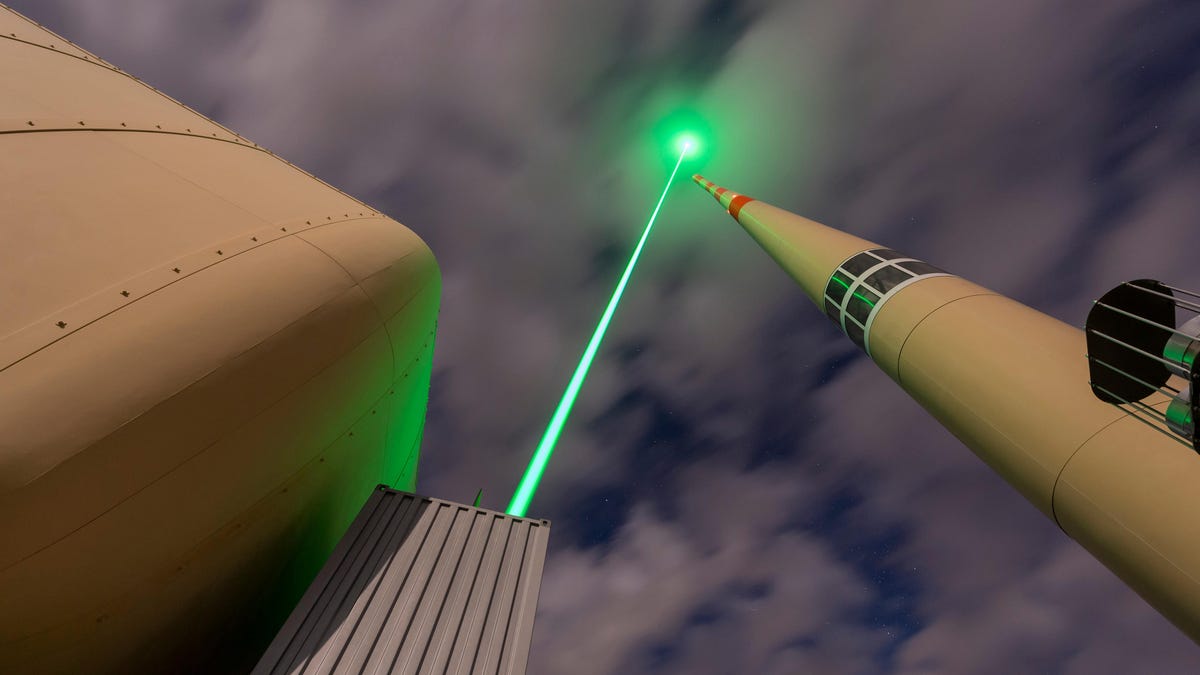Scientists Divert Lightning Strikes Using a Powerful, Car-Sized Laser
On top of a Swiss mountain, a car-sized laser has helped guide lightning from the sky to the ground.

The laser lightning rod projects a green beam into the sky.
As NASA battled to get its huge next-generation moon rocket to the launchpad in early 2022, it had to contend with some severe and ugly Floridian weather. A storm system moved in, replete with rains and lightning, threatening the rocket as it waited on the pad for its launch rehearsal. During the storms, the launch zone was hit by lightning four times.
Fortunately, NASA had protected the pad with its lightning towers -- giant, metal structures designed to attract lightning and safely carry the charge to the ground. The basic design and idea behind a lightning tower hasn't changed much since its invention in the 18th century. But in 2021, scientists in north-eastern Switzerland were experimenting with a different type of lightning tower.
Cue the Dr. Evil voice: Giant freakin' laser beams.
A 3D reconstruction of the lightning strike on July 24, 2021.
In a study, published on Monday in the journal Nature Photonics, researchers describe their attempts to guide lightning with a laser beam on the top of the picturesque Säntis mountain at an altitude of over 8,000 feet.
During the summer of 2021, scientists installed a fast-pulsing laser, about the size of a car, next to a telecommunications tower on Säntis. Between July and September of that year, the picosecond laser -- which fires at around 1,000 pulses every second, was operated for more than 6 hours of thunderstorm activity. During observation, the comms tower was hit at least sixteen times, with four of those happening during laser activity. (Yes, lightning does strike twice... and sometimes more than that.)
One particular strike, on July 24, 2021, was captured in great detail. The skies were clear enough for high-speed cameras to capture the lightning strike, which appeared to follow the laser for around 50 meters (approximately 165 feet). The facility also had a VHF interferometer, which can measure the electromagnetic wave activity around the site. It was also possible to measure the X-rays for several of the laser-guided strikes.
Lightning is a complicated phenomenon, caused by an imbalance in positive and negative charges between storm clouds and the ground. It doesn't always travel from a cloud to the ground, either. Often, lightning will also travel upward. The team saw that lightning strikes occurring at Säntis were mostly upward strikes, which is in accordance with most of the strikes in the region.
As the researchers note in the discussion, guiding lightning strikes with laser pulses has been tried a couple of times before, in 2004 and 2011. These attempts were unsuccessful, so why did the Säntis mountain campaign go so well?
The team reasoned that the repetition rate of the laser -- how fast it's pulsing -- played a major role. The repetition of this particular laser is two orders of magnitude higher than previous experiments and may have allowed for interception of any lightning precursors developing above the tower. Further laser-guided lightning campaigns will be necessary to fully understand how this giant frickin' laser did the job.
That's a good thing. With around 40 to 120 lightning strikes occurring every second on Earth, there's a decent chunk of area, infrastructure and human life that needs protecting. There's also the fact that climate change, increasing populations and larger metropolitan areas will guarantee an intensification of lightning hazards to humanity, according to a 2018 paper in the journal Environmental Research Letters.
Lasers, though, have their own issues. For instance, it wouldn't seem wise to use a laser around an active air field -- and the researchers note in their methods they only operated this particular laser when airspace was closed. However, the paper notes this is an important first step forward in the development of new protection methods for airports, launchpads and large infrastructures.
Which means NASA's next moon mission might not have to be so afraid of that nasty Florida weather.

